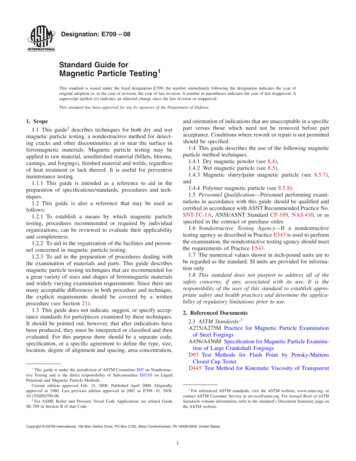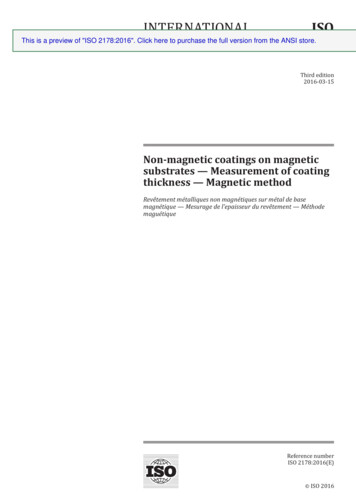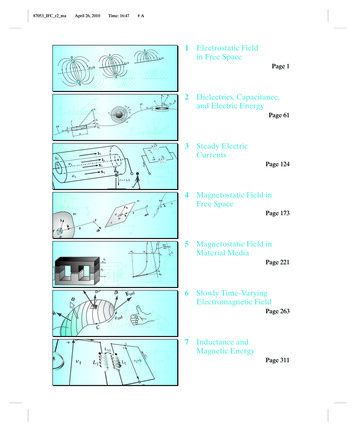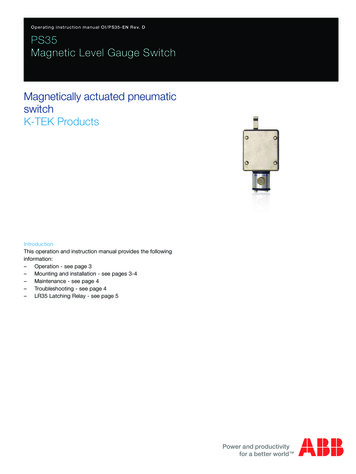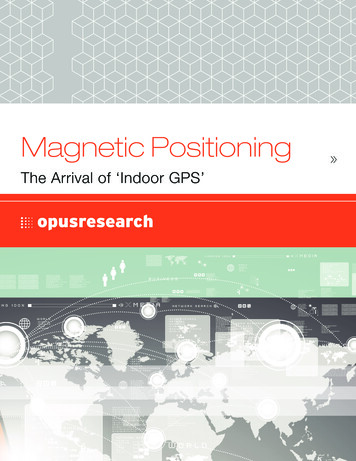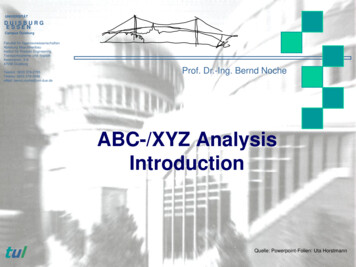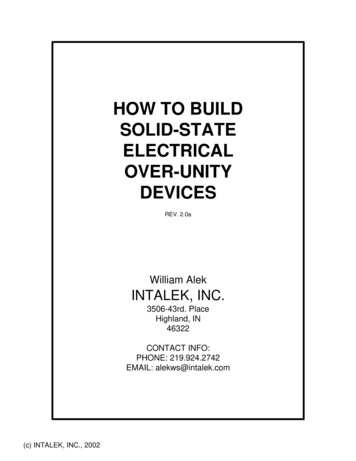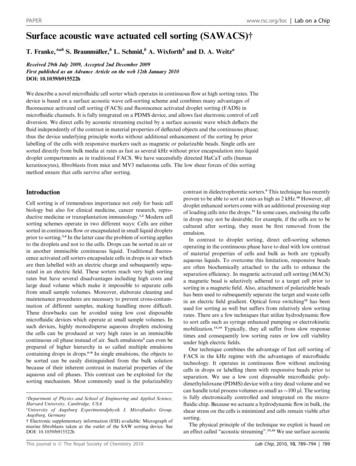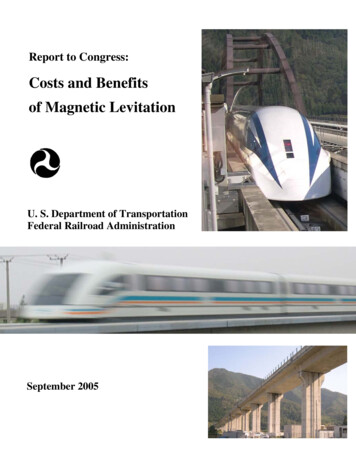
Transcription
Report to Congress:Costs and Benefitsof Magnetic LevitationU. S. Department of TransportationFederal Railroad AdministrationSeptember 2005
Table of ContentsExecutive Summary . ES-1Main ReportIntroduction. 1Background on Maglev . 1Maglev Technology Options. 1The German Technology . 2Japanese High-Speed Maglev . 3U.S. Maglev Technology . 5Maglev Deployment Program. 6Maglev Compared with Other Modes. 6Capital Costs . 8Costs of Maglev Systems. 8Cost Comparison with Other Modes of Transportation. 11Benefits Versus Costs . 14Transportation Perspective. 14Economic Perspective: Comprehensive Costs and Benefits. 26Maglev’s Advantages, Disadvantages, and Uncertainties . 35Potential Advantages . 36Potential Disadvantages . 37Uncertainties . 38Conclusions. 39Glossary of Terms and Acronyms . 41AnnexesAnnex A: Comparison of Maglev Projects Planned for U.S. and Germany Using TransrapidTechnologyAbstract . A-1Introduction . A-1Description Of Projects . A-2Summary of Project Differences and Similarities . A-6Comparison of Costs . A-9Conclusion. A-12Tables for Annex A . A-13Annex B: California High-Speed Rail Authority’s Reasons for Proposing Steel-WheelRather Than Maglev Technology . B-1Annex C: CFS Approach to Traffic Congestion Reduction. C-1Annex D: The Role of Frequency in the Travel Time Comparisons. D-1COVER PHOTO ACKNOWLEDGEMENT: Ronald A. Mauri of the Volpe National Transportation Systems Center,Cambridge, Massachusetts, took and contributed the cover photos of the Yamanashi Maglev test facility and vehiclein Japan (top and bottom) and of the Transrapid vehicle operating in Shanghai, China (center).[iv]
List of TablesTables in Main ReportTable 1: Sources and Distribution of Federal Funding Under the Maglev Deployment Program.7Table 2: Comparative Capital Cost, Trip Time, and Traffic Estimates for Maglev and New HSR in California 10Table 3: Costs Per Route-Mile Maglev Times IHSR; New HSR Times IHSR .13Table 4: Interaction of Line-Haul and Total Travel Times.15Table 5: Measures of Transportation Benefits and Costs Index Values based on IHSR 110 .22Table 6: Comparison of Demonstration Programs Metroliner and Maglev.24Table 7: Illustrative Capacities and Costs of Intercity Transportation Modes.25Table 8: CFS Approaches to Developing Benefit/Cost Measures for HSGT Systems.26Tables in Annex ATable A - 1: Summary Statistics for Planned Maglev Projects in U.S.& Germany.A-13Table A - 2: Indicators of Project Diversity.A-15Table A - 3: Comparison of Estimated Unit Capital Costs for Currently Planned Maglev Projects .A-16Table A - 4: Comparison of Estimated Annual O&M Costs and Unit Costs for Currently Planned MaglevProjects .A-17Table in Annex DTable D - 1: Total Travel Time Impacts of Maglev, With and Without Frequency Effects .D-3List of FiguresFigure 1: Levitation/Guidance Magnet Arrangements–Transrapid .2Figure 2: Japanese MLX 01.4Figure 3: Levitation Principle in Japanese System .4Figure 4: Per-Route-Mile Costs of Recently Estimated Maglev Systems .9Figure 5: Maglev Corridors: Total Capital Cost Versus Length.11Figure 6: Per-Mile Costs of HSGT Options.12Figure 7: Composition of Each Mode’s Total Travel Time, Chicago–Detroit City-Pair Example .16Figure 8: Modal Diversions Reflect Competitive Characteristics of Distance Groupings .17Figure 9: Competitive Position of HSGT in Three Sample City Pairs— Total Travel Time in Minutes .18Figure 10: Ideal Market Length for Maglev .19Figure 11: Measures of Transportation Benefits Versus Costs for Maglev, New HSR, and IHSR 110 .20Figure 12: Relationship Between Traffic Density and Operating Ratios in CFS Maglev Corridors .27Figure 13: Relationship Between Traffic Density and Surpluses per Route-Mile in CFS Maglev Corridors .28Figure 14: Relationship Between Traffic Density and Self-Financing in CFS Maglev Corridors .29Figure 15: Total Benefits Versus Total Costs for CFS Illustrative Corridors.30Figure 16: CFS Benefit/Cost Ratios In Total; For Users; and For the General Public .31Figure 17: Benefits from HSGT Highway Traffic Congestion Reduction .34List of BoxesBox 1: California’s Evaluation of Maglev.10Box 2: Comparison with the Metroliner Program .24Box 3: Other Measures of Transportation Efficiency .25[v]
Executive Summary:COSTS AND BENEFITS OF MAGNETIC LEVITATIONIn response to a Congressional request to compare the costs and benefits of magneticlevitation (Maglev) with those of other modes, this report provides technical background on thisnew form of transportation, identifies the types of travel markets that it could optimally serve,estimates its likely capital costs, and assesses the likely return in terms of transportation serviceand economics on the commitment of resources that Maglev investments would require.What Is Maglev?Maglev is an advanced transport technology in which magnetic forces lift, propel, andguide a vehicle over a specially designed guideway. Utilizing state-of-the art electric power andcontrol systems, this configuration can reduce or eliminate the need for wheels and many otherparts, thereby minimizing mechanical friction and permitting excellent acceleration, withcruising speeds on the order of 300 mph or more. Thus Maglev, if built on alignments thatsupport its highest capabilities, would provide: Passenger comfort and convenience; Matchless center-to-center travel times for city-pairs in the 200-300 mile distancerange for example, about one hour between midtown Manhattan and downtownBoston; and Air-competitive trip times at longer trip distances than other high-speed groundtransportation systems.Transrapid, a German company, has developed a Maglev technology that is in revenueservice in Shanghai, China, where it links the city with its airport. Japan has developed atechnologically different system that has reached the point where decisions on its deploymentcan be made.The United States has authorized, but not funded for construction, a Magnetic LevitationTransportation Technology Deployment Program (“Maglev Deployment Program”) that woulddemonstrate a relatively short (30-50 mile) Maglev system in commercial service. Projects arecurrently being planned in four locations: Baltimore/Washington (MD-DC); Pittsburgh (PA); LasVegas (NV)–Anaheim (CA); and Los Angeles International Airport (LAX)–Riverside (CA).While the President’s FY 2006 Budget (like those for each year since the program’s1998 enactment) does not request funding for the Maglev Deployment Program, Congress hasmade a total of 70.6 available for Fiscal Years 1999 through 2005. The flow and uses of thesefunds have been as follows:
Maglev Deployment Program Funding SummaryAnnual Program Funding for All ProjectsDistribution of Total Funds,FY 1999–FY 2005Comparable ModesMaglev most aptly comes into comparison with the other modes of high-speed groundtransportation (HSGT): incremental and new high-speed rail (HSR).1 Incremental HSR (IHSR)makes use of existing railways, upgraded for enhanced capacities and top speeds in the range of90 to 150 mph.2 New HSR, if implemented,3 would provide service at speeds reaching 175 to200 mph on new alignments and trackage over most of its distance, while accessing city centersover improved legacy railroads where appropriate. (Maglev’s top speed, as mentioned above,would be on the order of 300 mph.)Capital CostsFor the currently available Maglev technologies, the initial capital cost averaging some 40 to 100 million per mile for the most recently-estimated projects exceeds that of IHSR bya factor ranging from four-fold to nine-fold. Maglev’s unit capital costs surpass those of NewHSR by lesser, but still significant, amounts, ranging from 11 to 19 million per mile in recentstudies. Thus, the Maglev technologies of today are the most expensive form of HSGT in termsof up-front investment.1This report also compares HSGT modes with air and highway transportation under specific rubrics, such as traveltimes.2The prime example of Incremental HSR is Amtrak’s Northeast Corridor between Boston, New York, andWashington. Other corridors that exceed the normative 79 mph railway speed limit are New York–Albany, LosAngeles–San Diego, and short segments of trackage in the Midwest that have benefited from ongoing train controldevelopment projects.3There is no New HSR operation in the United States. The most notable examples overseas are the JapaneseShinkansen, French TGV, and German ICE.[ES-2]
Line-Haul Travel TimesConversely, Maglev could provide the highest average speeds and quickest station-tostation trip times available by any public mode of land transportation. A potential one-hour linehaul trip time between Boston and New York would be almost as fast as today’s best scheduledairline times.4Benefit/Cost AnalysisTo appraise Maglev’s value, the Federal Railroad Administration (FRA) has adopted twoapproaches. First, since very high speeds on the ground are Maglev’s chief claim to superiority,the “transportation approach” asks whether the travel time impact of Maglev on the markets itcan serve would suffice to justify its cost. This approach is discussed on pages 19 to 25 of theMain Report and summarized in Box ES - 1, below. Second, the “economic approach”(addressed on pages 26 to 35 of the Main Report and summarized in Box ES - 2) inquireswhether the total benefits to society of having Maglev in place counterbalance the associatedcosts.Transportation EffectsAs trips grow shorter, users of public transport spend an ever-higher portion of the totaltravel time in getting to and from stations, as opposed to the line-haul journey itself. Thus, nomatter how much faster Maglev can speed between terminals, there is nothing unique aboutMaglev that can expedite the passenger’s access to the originating station, and his or her egressfrom the arriving station to the ultimate destination. The shorter the trip, the less Maglev caninfluence the passenger’s total travel time.At the other end of the distance spectrum, at the 400-500 mile plateau, air travel begins tocatch up with Maglev on a door-to-door travel time basis, as the superior cruising speed of airovercomes its disadvantages with respect to terminal locations, access/egress, and timeconsumed in taxiing.Ideal Market Length for MaglevIn combination,these factors suggestthat Maglev’s optimalrange of travel lengthswould be betweenapproximately 150 and500 miles. Furthermore, these samefactors heavily4Federal Railroad Administration, High-Speed Ground Transportation for America, September 1997, p. O-34 andStatistical Supplement, p. 19.[ES-3]
influence the comparisons of Maglev projections with those for other modes, as summarized inBox ES - 1.Box ES - 1 Summary of Results5:TRANSPORTATION APPROACH TO BENEFITS/COSTS The primary justification for Maglev’s high initial cost must be its promised reductions in traveltimes. Essential, therefore, to an evaluation of Maglev is its cost per unit of time saved versus thecost of time savings in comparable modes.In most corridors, Maglev shows increased costs and reduced benefits in comparison withincremental high-speed rail (IHSR 110) on the measures used in this report: The cost per unit of time savings for Maglev is double or triple that of IHSR; Maglev’s transportation production per investment dollar is well below that available throughIHSR; and The value of transportation provided to system users (fare revenues plus consumer surplus)per investment dollar is more favorable for IHSR than for Maglev.As the difference between New HSR and Maglev is much less pronounced on these measures, nogeneralizations can be made of the basis of the available projections.Economic EffectsFRA’s Commercial Feasibility Study (CFS) of HSGT, completed in 1997, compared thesocial benefits and costs of Maglev with those of comparable modes. The benefits includedcongestion relief on parallel air and highway systems, emissions reductions from passengerdiversions to cleaner modes, and benefits to HSGT users. The CFS results (summarized in BoxES - 2) clearly differentiated the benefit/cost ratios of Maglev from those of IHSR, while thedifferences between Maglev and New HSR were less pronounced.Box ES - 2 Summary of Results6:ECONOMIC APPROACH TO BENEFITS/COSTS Maglev’s projected benefits exceeded its costs in only two heavily populated, relatively longcorridors the Northeast Corridor (441 miles, plus extensions to the Southeast and in New YorkState) and California (527 miles);In most of the corridors studied, either IHSR or New HSR produced higher benefit/cost ratios thanMaglev.Under the Commercial Feasibility Study assumptions, IHSR emerged as the most cost-effectiveapproach (among HSGT options) to reducing highway traffic congestion in most intercity corridors.Maglev, with its expected ability to attract passengers from airlines, might assist inreducing the growth of local highway congestion generated by airport access and egress. Thepotential for such assistance at a specific air terminal would depend on the market reach of56Based on Federal Railroad Administration, High-Speed Ground Transportation for America, September 1997.Ibid.[ES-4]
available, air-competitive Maglev service; the origin/destination mix of the air passengers usingthe terminal; and their habitual modes of ground travel to and from the airport.Some direct shifting of intercity automobile trips to Maglev would also be anticipated.The extent of such diversions, and their potential impacts on congestion in affected highways,would depend largely on each corridor’s characteristics (for example, on comparative total traveltimes by Maglev and by auto in the constituent city-pairs), on prevailing gasoline prices, and onthe fare policy adopted for Maglev. By emphasizing maximization of operating surpluses ratherthan that of gross revenues or ridership, the CFS tended to gear its Maglev fare levels toward airrather than toward auto diversions. Other fare assumptions might have yielded proportionatelyhigher projected diversions of auto travelers to Maglev but to the likely detriment of eachMaglev corridor’s commercial feasibility as foreseen by the CFS.Of the two corridors in which Maglev showed favorable benefit/cost ratios, California acting through the California High-Speed Rail Authority is proposing to develop New HSRdue primarily to the latter’s connectivity, environmental friendliness, and ability to make flexibleuse of existing rail rights-of-way in sensitive, densely-settled areas.7 The Northeast Corridor(NEC) presents formidable institutional, engineering, and environmental obstacles to theintroduction of Maglev along much of its length, as well as other investment needs centering onthe high-volume commuter and intercity rail passenger services that depend on the existing,aging fixed plant. Even if a parallel New HSR or Maglev system were constructed, many of theinvestment requirements of today’s NEC main line would remain, as it would undoubtedlycontinue to provide for important commuter and intercity feeder operations. In any event,proposals for building a new HSGT system throughout the NEC are not presently underconsideration by responsible authorities.UncertaintiesMaglev is a new mode currently under development in a number of countries, with a solerevenue installation in regular service in Shanghai only since April 2004.8 As with anyembryonic transport mode, there exist numerous uncertainties, such as:78 The long-term capital, operating, and maintenance costs of currently availabletechnologies; The long-term performance characteristics of these technologies for instance, theirall-weather reliability under American conditions, in comparison with currentlyavailable modes; The opportunities for technological breakthroughs that might substantially reduce thelife-cycle costs of installing, operating, and maintaining a Maglev system; Innovative performance upgrades and unforeseen safety drawbacks that mightmanifest themselves in the decades to come;See Annex B.CNN/Reuters, “China to Cut Costs on New Maglev Link,” December 7, 2004, aglev.cost.reut/index.html[ES-5]
Public reaction to various types of Maglev systems, in terms of demand and revenueover a range of stage lengths; and, more generally The long-term effects of September 11, 2001; ensuing changes in travel demand, thesecurity environment, total travel times, and competitive positions of the airand potentially other modes; and structural changes in the airline, rail passenger,and other transportation industries.The present report necessarily bases its analysis and conclusions on currently availableMaglev systems and extant projections of those and other HSGT systems’ performance.However, neither the spectrum of Maglev technologies nor the American transportationenvironment will likely remain static throughout the 21st Century.ConclusionsAlthough each region conducting planning under the Maglev Deployment Program isbest able to evaluate the benefits and costs of the proposed projects within its own region, theFederal Government must view Maglev in the context of national needs and priorities. From alocal perspective, a particular project may promise overwhelming benefits in relation to its costs.Nothing in this study should suggest that a State or metropolitan area not act accordingly, withinits own financing capabilities and those of its potential partners, and subject to such applicableFederal laws as those bearing on safety and the environment. However, from a strictly Federalviewpoint, this report reaches the following conclusions: Intercity systems based on currently available Maglev technologies are expensive,with high per-mile costs. Conversely, if implemented, Maglev might provide line-haul travel times thatimprove on those of any other mode of ground transportation. The followingnoteworthy factors place Maglev travel times in their broader context: Maglev’s line-haul speed advantage can only result in substantial total travel timeimprovements in markets in which line-haul travel times are a significantproportion of total travel times i.e., in markets more than approximately 150miles in length. Beyond trip distances of about 500 miles, air’s superior cruising speeds wouldbegin to detract from Maglev’s advantages of station location and access. Therefore, Maglev’s most appropriate transportation niche is in corridors ofextremely high travel density that include strong city-pair markets in the 150-to500-mile range.In the densely populated corridors where Maglev has the greatest potential foryielding significant transportation benefits to recompense its costs, existingdevelopment, environmental concerns, and other practical constraints would make itvery challenging to acquire and develop an alignment that permits current Maglevtechnologies to fully achieve their trip time improvement capabilities.In comparison with today’s available Maglev systems, other contemporary HSGTtechnologies (IHSR and, in some cases, New HSR) typically show higher projectedtransportation and economic benefits, including highway traffic congestion relief,[ES-6]
relative to their costs, and could bring many of the advantages of HSGT to manymore markets at much less cost. The proposed short-distance demonstrations under the Maglev Deployment Program,if any are constructed, could ultimately produce operational, engineering, andfinancial data on Maglev under American conditions, at a lower level of outlay andrisk than would pertain to a lengthier and costlier installation. Such data mightaugment information gathered in other countries that have already invested significantresources in Maglev technology, in the event that private and public entities in theUnited States should someday contemplate longer-distance Maglev systems incorridors of the highest density. In and of themselves, however, the short corridorsunder consideration in the Maglev Deployment Program would not fully demonstrateMaglev’s transportation potential, which is best perceived in systems serving intercitycorridors over some 150 miles long.As a form of transportation based on new technologies, Maglev is subject to a highdegree of uncertainty. Consequently, whatever policy the Federal Government adoptstoward Maglev in the short term, the American transportation community includingthe private sector might profitably monitor the Maglev industry for noteworthychanges in its prospective costs, benefits, performance, and applicability to theevolving transportation environment in the United States.As Maglev’s capabilities, challenges, and cost-effectiveness in a particular regionmust remain speculative until they undergo examination on a site-specific basis,public officials may wish to weigh the desirability of including Maglev, in light of itsevolving characteristics through the years, as a technological alternative in futurestudies of high-density corridors.[ES-7]
Main Report:COSTS AND BENEFITS OF MAGNETIC LEVITATIONIntroductionThis report responds to a request contained in House Report 108-401, the ConferenceReport to Accompany H.R. 2673 (the Consolidated Appropriations Act, 2004):In order to assist in the evaluation of the potential of magnetic levitation toachieve traffic congestion relief and determine its appropriate role in our nation'stransportation system, the conferees direct FRA to provide the House and SenateCommittees on Appropriations a report comparing the costs and benefits ofmagnetic levitation to other modes of travel. This report should be undertakenwhile moving forward on submitted projects.9To fulfill this request, the report describes today’s technological approaches to magneticlevitation (Maglev); analyzes Maglev’s transportation-related and economic benefits and costs,with reference to comparable modes of travel; and discusses Maglev’s advantages,disadvantages, and uncertainties.It is not the purpose of this report to critique the individual projects receiving planningfunds under FRA’s Magnetic Levitation Transportation Technology Deployment Program(“Maglev Deployment Program”). Individual project characteristics are mentioned only for thepurpose of illustrating Maglev’s “appropriate role in our nation’s transportation system,” inkeeping with the Congressional report language.Background on MaglevAs a backdrop to Maglev’s benefits and costs, this section discusses the most prominentMaglev technologies and the Maglev Deployment Program. Further information appears inAnnex A.Maglev Technology OptionsThis section describes the most prominent Maglev systems currently available or underintensive development.All Maglev technologies share the basic principle of substituting magnetic forces for thedirect physical contact between vehicle and fixed infrastructure that characterizes other groundtransportation modes. These magnetic forces may be either repulsive (as when the north poles oftwo magnets are brought face-to-face) or attractive (as when opposite poles of two magnets arebrought near each other).9House Report 108-401, the Conference Report to Accompany H.R. 2673 (the Consolidated Appropriations Act,2004, Division F Departments of Transportation and Treasury, and Independent Agencies Appropriations Act,2004), dated November 25, 2003, p. 976.
The German TechnologyThe Germans have undertaken development of a variety of high-speed groundtransportation (HSGT) technologies. In the early 70's, repulsive and attractive Maglev and aircushion technologies were brought to a half-scale demonstration stage. Repulsion waseliminated largely because of the perceived complexity of the superconducting subsystem, whileair cushion was eliminated for reasons of noise and energy consumption. Subsequentdevelopment has focused on attractive Maglev. The initial systems employed linear inductionmotors, but as speeds increased these were abandoned in favor of the linear synchronous motor(LSM),10 as a measure to reduce on-board weight.The current German Transrapid Maglev design uses a vehicle about 82 feet in length and12.2 feet wide, with seats for about 100 in coachFigure 1: Levitation/Guidance Magnetclass. Trains generally consist of three to tenArrangements–Transrapidsections. The guideway is “T”-shaped; it isgenerally elevated, and can be fabricated fromsteel, concrete or a hybrid design. Levitation isaccomplished by conventional electromagnetsattached to the vehicle (see Figure 1), which pullthe vehicle upward toward iron stator packsmounted on the guideway. As the magnetapproaches the rail, the attractive force getsstronger; thus, it is necessary to employ feedbackto rapidly decrease the current in the magnet asthe gap closes. Transrapid states that “a highlyreliable, redundant electronic control systeminsures that the vehicle levitates at a constant distance of [3/8 of an inch] to its guideway.”11Propulsion of the Transrapid vehicle is by means of an LSM whose primary windings (orstator) are embedded in the guideway while the secondary (or rotor) consists of the levitationmagnets on board the vehicle. The frequency of the alternating current fe
influence the passenger’s total travel time. At the other end of the distance spectrum, at the 400-500 mile plateau, air travel begins to catch up with Maglev on a door-to-door travel time basis, as the superior cruising speed of air overcomes its disadvantages with respect to termina
